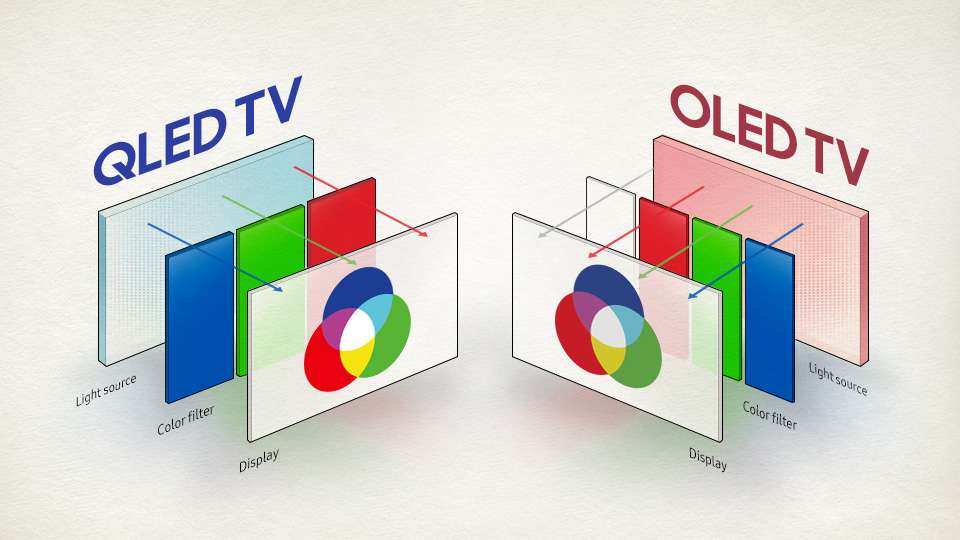
QLED vs OLED: A Complete TV Buyer Guide

Choosing between QLED vs OLED can be a bit of a dilemma. After all, you want to opt for the best one to enjoy your cable or Spectrum TV Packages shows. There are a lot of factors that one needs to consider before making their final purchase, including accurate viewing angle, the right contrast levels, and good display quality. Why? Well, because no one would ever want to regret their decision after the realization that the option they selected has fallen short of their expectation.
This comprehensive guide will highlight the two competing TV technologies. It will discuss what both QLED and OLED are, how they are different, and what each one does well. So, without any further ado, let’s begin!
QLED
LCD display along with Quantum particles or dots are used in the making of QLED screens. It is these dots that let out brightness and color. A QLED is governed by the LEDs that are unified into an LCD panel. You can find hundreds of thousands of LEDs on the screen which is what provides backlight to the LCD panel, illuminating the display.
This technology was first introduced by Sony in 2013. However, Samsung quickly took the lead of its production and now offers the license of QLED TV to different companies such as Hisense, Vizio, TCL, and Sony.
OLED
OLED differs from QLED. In these screens, there is neither an LED backlight nor it requires any backlight source. It all depends on the pixels that emit light in the display. These pixels act like an LED light. They can produce both light and color at once.
LG Display is the only company that is currently producing OLED TV panels. It then sells the panels to its sister company LG Electronics in addition to Panasonic, Philips, and Sony.
QLED vs OLED
Now that you know how QLED and OLED differ from one another, let’s see how these two technologies fare against each other in different categories that matter the most when it comes to purchasing a television.
1. Brightness
Supported by LED backlights, the display of the QLED TV is brighter as compared to OLED. The strength of a quantum particle light that it emits can be increased to a point where it will not lose its color saturation. This means that if your TV is set up in even the brightest of spots, the display of QLED will not become dim.
However, OLED TVs are not like QLEDs. Televisions installed with this technology will work best in slightly lit places. This is because the OLED pixels fail to produce radiant display in any room that is brightly lit.
QLED takes the point here!
2. Color
QLED and OLED run head to head when they are compared with respect to color brightness. QLED’s quantum particles play their role in making the color quality of the display brighter and more accurate. They can easily display a diverse range of colors in any given palette. OLED on the other hand also provides an impressive range of colors.
3. Viewing Angle
If you want to go for QLED then remember that it will be ideal if you view the display from the center. If not, then there is a chance of the brightness, color, and contrast to dim out. On the other hand, opting for the OLED means that if your viewing angle is majorly or slightly skewed, the contrast, brightness, and picture quality will remain crisp. The latter is clearly the winner here.
4. Contrast
QLED does not push the display to either side, dark or bright, and gives a good contrast result. The darker details appear to be clear on such screens.
OLED can easily maintain the desired levels of contrast. It will not overly focus on making the darker scenes brighter but in fact, it will strike a balance. However, this technology has its cons. For instance, if a scene is really dark then it will become harder for you to view it.
Both of these displays have their own contrast levels. But if you do not want your video games to appear visually murkier, then it will be a good move to opt for QLED. Also, while playing online games, you would need to subscribe to a solid internet connection such as Spectrum internet or it will lag.
Conclusion
Both QLED and OLED have their pros and cons. As far as the factors of contrast and brightness are concerned, QLED is an easy winner. Whereas, OLED did well in terms of viewing angle, contrast, and also color precision. Ultimately, the decision is yours to make. So as long as you know what your viewing needs are, you can choose the option that will best meet your requirements.




